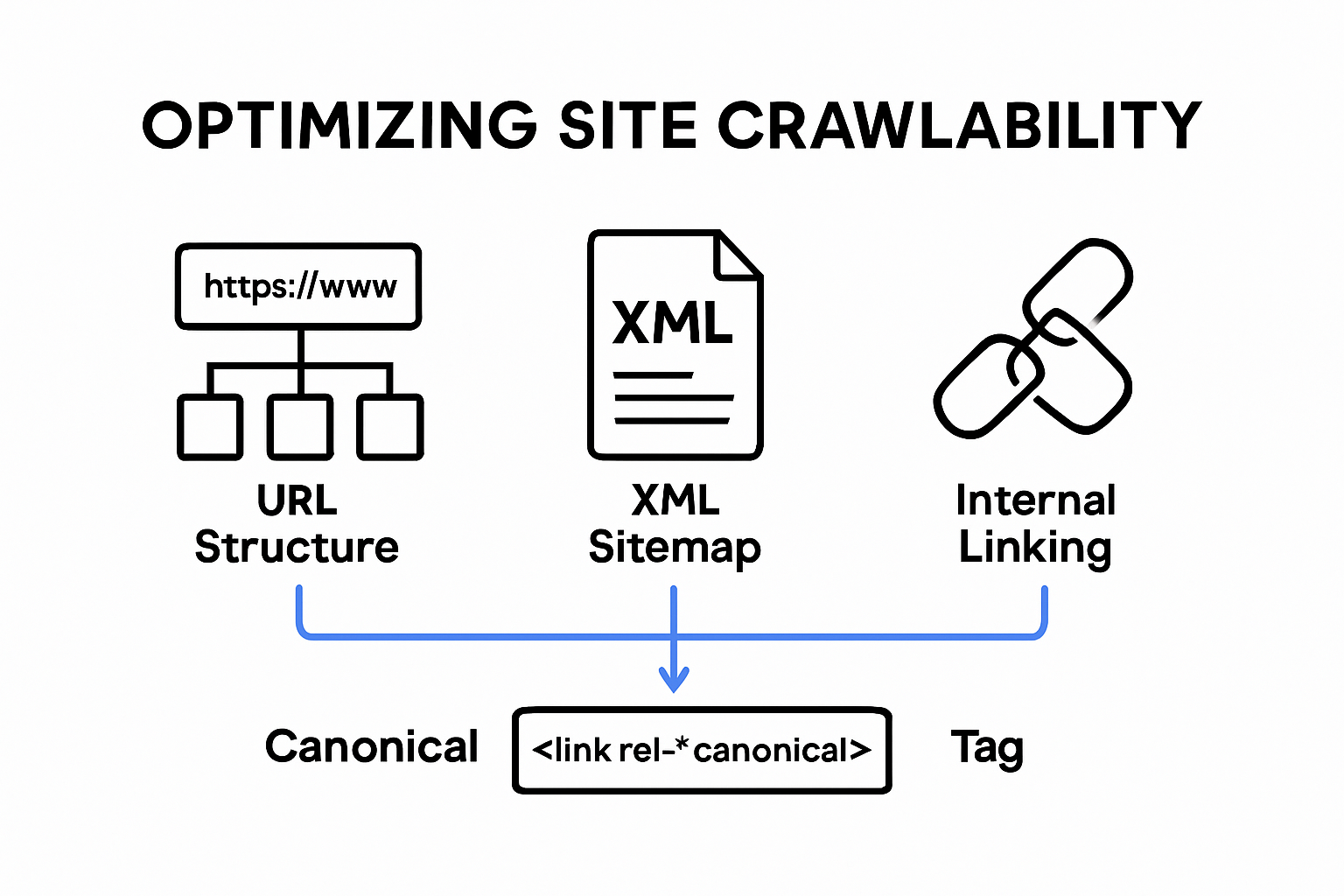Site Architecture Best Practices for 2025: Simple Steps to SEO Success


Site architecture might sound like a backend detail that only web developers care about. Yet 50 percent of redirecting URLs lead to errors and hurt search visibility, which impacts everyone from site owners to daily users. Now for the surprising part. The smartest site structures in 2025 are not the most complicated ones—they are the simplest, making it possible to reach any page in just three to four clicks and giving both users and search engines exactly what they want.
Table of Contents
- Understanding Site Architecture In 2025
- Key Elements Of Effective Site Structure
- Best Practices For Seo And User Experience
- Common Mistakes And How To Avoid Them
Quick Summary
| Takeaway | Explanation |
|---|---|
| Create an intuitive site hierarchy | Organize content so users access any page within three to four clicks from the homepage for better navigation. |
| Implement strategic content clusters | Link related pages through topic clusters to enhance topical authority and improve search rankings. |
| Optimize for mobile responsiveness | Ensure your design adapts seamlessly across devices to enhance user experience and meet search engine criteria. |
| Utilize clean URL structures | Use descriptive, concise URLs with meaningful keywords for better accessibility and search engine understanding. |
| Regularly audit and refine architecture | Continuously assess site structure and performance to maintain user-friendliness and SEO effectiveness. |
Understanding Site Architecture in 2025
Website architecture has transformed from a simple organizational strategy to a critical component of digital success. In 2025, site architecture represents the strategic blueprint that determines how search engines and users navigate and understand your online presence.
The Evolution of Digital Navigation
Modern site architecture goes far beyond basic page linking. Search Engine Journal highlights that successful websites now require intricate, intelligent navigation systems that serve dual purposes: enhancing user experience and facilitating precise search engine crawling.
The core principle remains consistent: create a logical, intuitive structure that guides visitors seamlessly while providing clear signals to search algorithms. This means developing a hierarchical content organization that reflects both user intent and topical relevance. Websites are no longer just collections of pages but interconnected ecosystems of information.
Strategic Content Clustering
Search Engine Land emphasizes the importance of topic clusters in modern site architecture. These clusters represent a sophisticated approach to content organization where related pages are strategically linked, creating a comprehensive network of information. By establishing clear relationships between content pieces, websites can demonstrate topical authority and improve search ranking potential.Effective topic clustering involves:
- Centralized pillar content that provides comprehensive overviews
- Detailed cluster pages addressing specific subtopics
- Logical internal linking that connects related content
Technical Foundations of Modern Site Structure
WebStacks underscores that robust site architecture in 2025 requires more than aesthetic design. Technical considerations like mobile responsiveness, page load speed, and structured data implementation are fundamental. Search engines increasingly reward websites that provide not just relevant content, but also exceptional user experiences.Navigation elements such as breadcrumbs, clear menu structures, and XML sitemaps have become essential tools for both user guidance and search engine comprehension. These elements help search algorithms understand your site's content hierarchy, potentially increasing the likelihood of earning rich search results like sitelinks.
By approaching site architecture as a holistic strategy that balances technical optimization, content relevance, and user experience, businesses can create digital platforms that not only attract visitors but also engage and convert them effectively.
Key Elements of Effective Site Structure
Creating an effective site structure requires strategic planning and precision. Success hinges on understanding and implementing core architectural principles that enhance both user experience and search engine performance.
Shallow and Intuitive Hierarchical Design
Search Engine Journal emphasizes that site architecture should follow a shallow, logical hierarchy. This means organizing content so that users can reach any page within three to four clicks from the homepage. A shallow structure not only improves user navigation but also signals to search engines the relative importance and relationships between different pages.Implementing this approach requires careful content categorization. Group related content logically, creating clear pathways that guide users through your digital ecosystem. Each category should have a clear purpose and provide a natural progression of information.
Mobile-First Responsive Architecture
SEMrush highlights the critical importance of mobile-friendly design in modern site architecture. With increasing mobile internet usage, websites must adapt their structure to provide seamless experiences across all device types. This means more than just responsive design - it involves reimagining site navigation and content presentation for smaller screens.Key mobile optimization strategies include:
- Simplified navigation menus that collapse intuitively
- Touch-friendly interface elements with appropriate spacing
- Responsive images and media that scale without losing quality
Optimizing Crawlability and Indexing
WebStacks reveals that website architecture directly impacts how search engines discover and understand your content. A well-structured site enables search engine bots to efficiently crawl and index pages, which is fundamental to achieving better search visibility.To enhance crawlability, implement technical elements such as:
- Clean, descriptive URL structures
- Comprehensive XML sitemaps
- Strategic internal linking
- Proper use of canonical tags

Effective site structure is not a static concept but an ongoing process of refinement. Regular audits and adaptations ensure your digital platform remains user-friendly, technically sound, and optimized for search engine performance. By treating site architecture as a dynamic strategy, businesses can create digital experiences that attract, engage, and convert visitors with remarkable efficiency.
Best Practices for SEO and User Experience
Aligning search engine optimization with exceptional user experience requires a nuanced approach that balances technical requirements and human-centered design. In 2025, successful websites must create seamless interactions that satisfy both algorithmic and user expectations.
Design Elements for Enhanced Engagement
National Center for Biotechnology Information research highlights critical design elements that drive user engagement. These include effective navigation, clear graphical representation, logical organization, content utility, purposeful design, simplicity, and high readability. By prioritizing these elements, websites can simultaneously improve search engine rankings and user satisfaction.Successful implementation means creating intuitive pathways that guide users effortlessly through content. This involves developing clear menu structures, using descriptive headings, and ensuring that each page serves a specific, transparent purpose. Navigation should feel natural, almost invisible to the user while providing comprehensive access to information.
Below is a checklist table summarizing key design elements and implementation status for optimal user engagement, as discussed above:
| Design Element | Importance | Implementation Example |
|---|---|---|
| Effective navigation | Critical for usability | Clear menu structures, breadcrumbs |
| Clear graphical representation | Enhances understanding | Simple icons, clear images |
| Logical organization | Guides user journey | Progressive content structuring |
| Content utility | Delivers genuine value | Factual, actionable information per page |
| Purposeful design | Streamlines interaction | Page serves single, clear objective |
| Simplicity | Prevents confusion | Minimal distractions, clean layout |
| High readability | Supports learning & retention | Readable font, concise language |
Managing Technical Performance
Arxiv Research reveals critical insights into URI management. Their analysis of 11 million unique redirecting URIs demonstrated that proper technical configuration is fundamental to maintaining SEO performance. With 50% of redirections potentially resulting in errors, meticulous attention to technical details becomes paramount.Key technical optimization strategies include:
- Precise URL structure that reflects content hierarchy
- Minimal redirect chains to prevent user frustration
- Clean, semantic HTML that helps search engines understand page context
- Fast loading times across all devices
Visual Complexity and User Learning
Visual Design Research provides fascinating insights into web design complexity. Their study indicates that less visually complex pages correlate with higher user learning success. This underscores the importance of creating clean, focused design that eliminates unnecessary visual noise.Achieving optimal visual design involves:
- Whitespace utilization to create breathing room
- Clear typography that enhances readability
- Consistent color schemes that guide user attention
- Responsive design that adapts seamlessly across devices
Ultimately, best practices for SEO and user experience converge on a single principle: create websites that provide genuine value through clear, accessible, and meaningful interactions. By treating users as intelligent participants rather than passive consumers, businesses can develop digital experiences that are both algorithmically sound and deeply engaging.
Common Mistakes and How to Avoid Them
Navigating the complex landscape of site architecture requires understanding potential pitfalls that can undermine your digital strategy. Recognizing and proactively addressing common mistakes can significantly improve your website's performance and search engine visibility.
Below is a summary table of common site architecture mistakes and actionable solutions to help you avoid them:
| Mistake | Example/Symptom | Solution |
|---|---|---|
| Complex or non-descriptive URLs | /page?id=12345, long strings of numbers/letters | Use clear, keyword-rich, concise URLs |
| Non-mobile-responsive design | Layout breaks on phones, small unreadable text | Implement responsive layouts, scale text |
| Fixed-width or rigid layouts | Content cut off or requires side-scrolling | Use fluid, adaptable designs |
| Excessive or broken redirects | Frequent redirect loops, "Page not found" errors | Minimize redirects, regularly audit links |
| Inconsistent navigation structures | Confusing menus, hard to find pages | Standardize menus, use logical hierarchies |
| Too many clicks to find info | Users lost after several clicks | Keep important pages within 3-4 clicks |
URL Structure and Naming Conventions
University of Maryland Libraries provide critical insights into effective URL management. Poor URL structures can confuse both users and search engines, creating unnecessary barriers to content accessibility. The most common mistakes include using complex, lengthy URLs with random characters or numeric strings that provide no meaningful context.To create SEO-friendly URLs, focus on these key principles:
- Descriptive and concise naming that reflects page content
- Lowercase characters to prevent potential routing issues
- Meaningful keywords that provide immediate content context
- Hyphens for word separation instead of underscores or spaces
A well-crafted URL acts as a mini-description, giving users and search engines immediate understanding of the page's purpose before they even click.
Mobile Responsiveness Failures
University of Utah Webmaster Resources emphasize the critical nature of mobile-responsive design. Websites that fail to provide consistent experiences across different devices risk significant performance penalties. With Google's mobile-first indexing, a non-responsive design can dramatically reduce search visibility and user engagement.Common mobile design mistakes include:
- Fixed-width layouts that do not adapt to screen sizes
- Unreadable text on smaller devices
- Inappropriately sized touch elements
- Slow loading times on mobile networks
Redirection and Navigation Complications
Arxiv Research reveals alarming statistics about web redirections, with 50% of redirecting URIs experiencing potential errors. Excessive or improperly managed redirects can create significant user frustration and negatively impact search engine crawling and indexing.To avoid redirection pitfalls, implement these strategies:
- Minimize redirect chains to prevent user drop-off
- Use 301 permanent redirects for consistent link equity transfer
- Regularly audit redirect paths to identify and remove unnecessary hops
- Implement clear, logical site navigation that reduces the need for complex redirects

Effective site architecture is not about perfection but continuous improvement. By understanding these common mistakes and proactively addressing them, businesses can create more robust, user-friendly, and search-engine-optimized digital experiences. Regular audits, user feedback, and staying updated with evolving web standards are key to maintaining a high-performing website.
Frequently Asked Questions
What is site architecture, and why is it important for SEO in 2025?
Site architecture refers to the strategic organization and structure of a website that influences how users and search engines navigate and understand the content. In 2025, having an effective site architecture is crucial for SEO because it enhances user experience, improves crawlability for search engines, and helps you rank better in search results.
How can I create an intuitive site hierarchy for my website?
To create an intuitive site hierarchy, organize your content so that users can reach any page within three to four clicks from the homepage. Use clear categories and labels, ensuring that related content is logically grouped together to guide users smoothly through your site.
What are content clusters, and how do they benefit SEO?
Content clusters are a method of organizing related content on your website by linking pillar pages with detailed cluster pages. This strategy helps establish topical authority, enhances user engagement, and improves search visibility, as search engines can better understand the relationships between different pieces of content.
What are some common mistakes in site architecture I should avoid?
Common mistakes include using complex or non-descriptive URLs, failing to provide a mobile-responsive design, having excessive or broken redirects, and creating inconsistent navigation structures. Addressing these issues can significantly improve your site's performance and user experience.
Transform Your Site Architecture Into a Real SEO Advantage
Are you struggling to build a site structure that your users love but still want to rank better on search engines? If you recognized challenges like confusing navigation, inefficient content organization, or missed ranking opportunities mentioned in the article, you are not alone. Many businesses get stuck trying to execute smart content clustering or maintain mobile-first, highly crawlable architecture. Each misstep can frustrate visitors and slow your growth.

Take control with BabyLoveGrowth.ai. Our platform turns SEO theory into real-world results with an automated, three-step solution. Start with a deep analysis of your business and competitors, then put a tailored 30-day content plan to work for your website. Finally, watch as AI-generated content improves your structure, fills ranking gaps, and elevates your entire digital presence. Make your next step the simplest one. Visit https://babylovegrowth.ai now to get a winning site architecture and outrank the competition.
Recommended
Smart SEO,
Faster Growth!
Most Read Articles

Generative Engine Optimization (GEO)
Learn how Generative Engine Optimization (GEO) helps your content rank in AI search engines like ChatGPT and Google AI. This comprehensive guide explains the differences between SEO and GEO, why it matters for your business, and practical steps to implement GEO strategies for better visibility in AI-generated responses.

Track LLM Traffic in Google Analytics 4 (GA4)
Learn how to track and analyze traffic from AI sources like ChatGPT, Claude, Perplexity, and Google Gemini in Google Analytics 4. This step-by-step guide shows you how to set up custom filters to monitor AI-driven traffic and make data-driven decisions for your content strategy.

How to Humanize AI Text with Instructions
Learn practical techniques to make AI-generated content sound more natural and human. This guide covers active voice, direct addressing, concise writing, and other proven strategies to transform robotic text into engaging content.

Open AI Revenue and Statistics (2024)
Comprehensive analysis of OpenAI financial performance, user engagement, and market position in 2023. Discover key statistics including $20B valuation, $1B projected revenue, and 100M+ monthly active users.